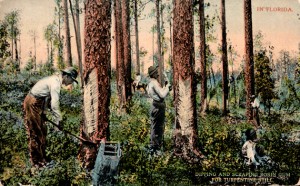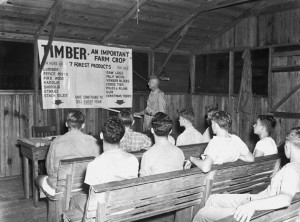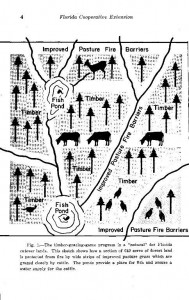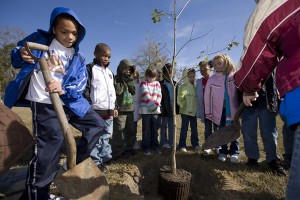Few things embody our hopes for the future better than planting a tree. That idea of a simple act making life better for future generations is at the heart of Arbor Day, which we celebrate in Florida the third Friday of January (the 17th this year, if you want to mark it on your calendar). Arbor Day was first celebrated on April 10, 1872, after a campaign led by journalist J. Sterling Morton, who lamented the lack of trees in his home state of Nebraska. That year, Nebraskans planted more than one million trees, and the celebration spread throughout the U.S. and other countries around the world.
Although we’re the state of tall pinewoods, majestic cypress, live oak and palm trees, Florida did not officially recognize Arbor Day until 1945. In the late 1800s, when the holiday was growing in popularity in the Midwest, Florida was in the throes of an economic boom fueled by the demand for pine gum. Turpentine, rosin, tar and pitch, all derived from pine gum or sap, were used to maintain wooden sailing ships, and tall yellow pine timber was used for ships’ masts. The “Naval Stores” industry flourished in the Panhandle and northern forests of Florida, where laborers and leased convicts, often working under brutal conditions, scraped off pine bark and cut the cambium with diagonal notches called ‘catfaces’ to drain the pine gum. Thousands of acres of pine trees were literally bled dry, and without replanting, stressed and weakened trees were subject to devastating fire and disease.

Source: Smathers Archives
In 1925, the Agricultural Extension Service tried to counter the effects of the turpentine boom by promoting sustainable forestry practices. As with many Extension programs, it began with 4-H. County agent Lewis T. Nieland organized a 4-H forestry club to teach youth the principles of tree identification, forest fire protection, income from forest products, tree replanting, and protection of game and other wildlife. Forestry was a new idea in Florida at the time; Nieland had little technical or material assistance, but with USDA bulletins and seedlings purchased from Louisiana, he and 12 club members planted 500 slash pine seedlings on a farm in Flagler County. Nieland made great progress with the 4-H forestry club, but when the Great Depression hit in 1929, tax collections dried up and the county was no longer able to pay his $60-a-month salary.

Source: Smathers Archives.
Nieland worked for the State Forest Service for several years, until in 1935 the newly formed Department of Forestry at UF’s College of Agriculture created a position for him as State Extension Forester. The main task for Extension forestry at the time was to help farmers manage their timber stands wisely to make them profitable and sustainable. By that time, pulpwood mills had started to move into the state, increasing the demand for pine timber. Farmers with small pine stands stood to profit, but their efforts to reforest their land put them in conflict with an unlikely foe—cattlemen. These were the days of the open range, when cattlemen weren’t required to fence in their herds, which were considered “four-footed property.” Each year, cattlemen burned off dry wiregrass on forest lands to promote the growth of fresh grass for their herds to graze in the spring. Aside from creating wildfires, these annual burnings killed off young pine seedlings, preventing the farmers from reforesting. To conserve the forests and avoid a conflict between farmers and cattlemen, Nieland devised a mixed-use plan for forest lands that involved planting strips of improved pasture grass around and through tree stands. The cattle could graze freely, the succulent forage grass acted as a shield against forest fires, and the mixed landscape encouraged the return of wildlife and game that further increased land value. “Timber-Grazing-Game,” as it came to be known, was very successful and is the basis of sustainable, mixed-use agroforestry practices that Extension promotes today.

Source: University of Florida Digital Collections.
Nieland also continued to teach forestry to 4-H clubs, even demonstrating how to sustainably extract gum from the very same slash pines that he planted with 4-H’ers fifteen years before. He served as the state Extension Forester until his retirement in 1956, after which he continued to pursue the planting of pine, hardwoods and red cedar around the state.
Today, UF and FAMU Extension programs in forest resources and conservation have vastly expanded on Lewis Nieland’s work, providing millions of Floridians with research-based, useful information about forest health, fisheries and aquatic sciences, forest stewardship, ecotourism, urban forestry, wildfire prevention, and wildland-urban interface issues.
In his introduction to a pamphlet on mixed-use forestry, Nieland wrote:
“Carelessness and unnecessary wastefulness, it may be admitted, contributed in part to the destruction of such great natural resources as forests and wildlife. In the conquest of a new domain this seems inevitable. On the other hand, the chief reason for widespread depletion may well have been the absence of a plan, or a program, designed to develop and maintain the basic resources and yet, practical enough to meet the everyday needs of the people.”
Making a plan, to meet the everyday needs of the people and to preserve our environment for future generations, is at the root of Extension’s work, and it’s what we do when we plant a seedling on this Arbor Day.

Photo by Tyler Jones.
To learn more about UF/IFAS Extension forestry programs today, visit the School for Forest Resources and Conservation.
Sources:
Cooper, J. Francis, ed. (1976) Dimensions in History: Recounting Florida Cooperative Extension Service Progress, 1909-76. Gainesville: Alpha Delta
Chapter, EPSILON SIGMA PHI.
Nieland, L.T. (1945) Timber-Grazing-Game. Agricultural Extension Service, University of Florida. Retrieved January 2014 from http://ufdc.ufl.edu/flag/results/?t=timber
School of Forest Resources and Conservation. (n.d.) History. Retrieved January 2014 from http://sfrc.ufl.edu/about/history
 0
0
